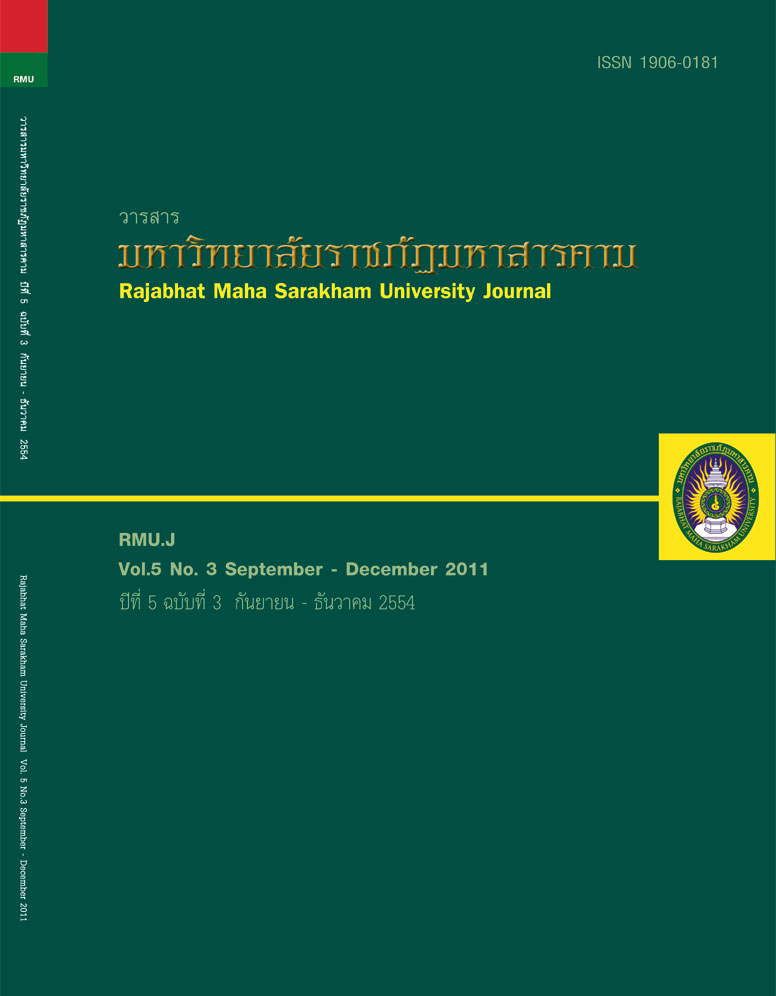รูปแบบการจัดการศูนย์การเรียนรู้เพื่อพัฒนาเด็กปฐมวัยแบบองค์รวม; Learning Centre Management Model to Holistic Development in Early Childhoo
Main Article Content
บทคัดย่อ
ารวิจัยนี้มีวัตถุประสงค์ ประการแรก พัฒนารูปแบบการจัดการศูนย์การเรียนรู้เพื่อพัฒนาเด็กปฐมวัยแบบองค์รวม ประการที่
สอง ศึกษาผลการเตรียมความพร้อมในการใช้รูปแบบ และประการที่สาม ศึกษาผลการพัฒนาเด็กปฐมวัยแบบองค์รวมโดยใช้รูปแบบ
การจัดการศูนย์การเรียนรู้ การวิจัยแบ่งเป็น 3 ระยะ คือ ระยะที่ 1 สร้างรูปแบบการจัดการศูนย์การเรียนรู้เพื่อพัฒนาเด็กปฐมวัยแบบ
องค์รวม ใชว้ ธิ วี จิ ยั เอกสาร ศกึ ษาดงู าน สนทนากลมุ่ เพอื่ สงั เคราะหเ์ ปน็ โครงรา่ งรปู แบบการจดั การศนู ยก์ ารเรยี นรู้ ระยะที่ 2 การเตรยี ม
ความพร้อมในการใช้รูปแบบ ใช้การวิจัยเชิงปฏิบัติการ กลุ่มตัวอย่างเป็นผู้บริหารและครูปฐมวัย โรงเรียนสาธิตมหาวิทยาลัยราชภัฏชัยภูมิ
จำนวน 4 คน ที่ทำการสอนในภาคเรียนที่ 1 ปีการศึกษา 2552 รวบรวมข้อมูลโดยการบันทึก ประจำวัน สังเกต และการสะท้อนผลร่วมกัน
ของครูและผูวิ้จัย ระยะที่ 3 การนาํ รปู แบบการจดั การศนู ย์การเรยี นรูที้พ่ ฒั นาขึน้ ไปใช้ โดยใชก้ ารวิจยั เชงิ ทดลองแบบกลุม่ เดยี วทดสอบ
ก่อนและหลัง กลุ่มตัวอย่างเป็นเด็กปฐมวัยชั้นปีที่ 1 ภาคเรียนที่ 2 ปีการศึกษา 2552 จำนวน 19 คน รวบรวมข้อมูลโดยใช้แบบประเมิน
พัฒนาการแบบองค์รวม และแบบบันทึกความสนใจเข้าเล่นศูนย์การเรียนรู้ของเด็ก วิเคราะห์ข้อมูลโดยการหาค่าเฉลี่ย ร้อยละ และ
เปรียบเทียบคะแนนพัฒนาการแบบองค์รวมก่อนและหลังการทดลอง ใช้สถิติทดสอบ Wilcoxon Signed Ranks Test ผลการวิจัยพบว่า
รูปแบบการจัดการศูนย์การเรียนรู้เพื่อพัฒนาเด็กปฐมวัยแบบองค์รวม มี 6 องค์ประกอบ คือ หลักการและความเป็นมา แนวคิด
และทฤษฎีพื้นฐาน วัตถุประสงค์ ขั้นตอนการสอน ระบบสนับสนุน การจัดการศูนย์การเรียนรู้ และในขั้นตอนการสอน ประกอบด้วย 5
กิจกรรม คือ เตรียมความพร้อม แนะนำศูนย์การเรียนรู้ เด็กเลือกศูนย์การเรียนรู้ ปฏิบัติกิจกรรมการเรียนรู้ และสรุปการเรียนรู้ร่วมกัน
การเตรียมความพร้อมในการใช้รูปแบบด้วยการวิจัยเชิงปฏิบัติการ 3 วงจร เพียงพอต่อการทำให้ครูปฐมวัยมีความเข้าใจ และมีทักษะ
ในการสังเกต การสะท้อนผล และอภิปรายการจัดการศูนย์การเรียนรู้ และการช่วยเหลือเด็กปฐมวัย
จากการศึกษาผลการพัฒนาเด็กปฐมวัยแบบองค์รวม พบว่า กลุ่มตัวอย่างมีคะแนนพัฒนาการแบบองค์รวมหลังการทดลองสูงกว่า
ก่อนการทดลองอย่างมีนัยสำคัญทางสถิติที่ระดับ .01 และจากผลการบันทึกความสนใจเข้าเล่นศูนย์การเรียนรู้ของเด็ก พบว่า ศูนย์การ
เรียนรู้ที่กลุ่มตัวอย่างสนใจเข้าเล่นมากที่สุด คือ ศูนย์วิทยาศาสตร์ ร้อยละ 22.10 รองลงมา คือ ศูนย์ศิลปะ ร้อยละ 18.50 และศูนย์
ภูมิปัญญาท้องถิ่น ร้อยละ 16.24 ศูนย์ที่มีจำนวนกลุ่มตัวอย่างสนใจเข้าเล่นน้อยที่สุด คือ ศูนย์บล็อก ร้อยละ 14.11;
The purposes of this research aimed to: firstly, develop learning centre management model to holistic
development in early childhood, secondly, study the results of ready preparation by using the model and
thirdly, study the results of holistic development in early childhood by using learning centre management
model. The research was divided into three phases: phase 1: created learning centre management model by
using research documentary, educational trip and focus group for synthesizing as a model structure, phase
2: ready preparation by using the model with action research. The subjects consisted of 4 administrators and
early childhood teachers who were teaching during the first semester of 2009 academic year at Chaiyaphum
Rajabhat Demonstration School. The data were collected by journal writing, observation and reflection of both
teachers and researchers, phase 3: implemented the learning centre management model. The research was
one group pretest - posttest design. The subjects were 19 early childhood students during the second semester
of the 2009 academic year. The instruments used in the research were: holistic development evaluation and
a record of the learning centre selection. Data analysis were mean, percentage and Wilcoxon Signed Ranks
Test for comparing the pretest - posttest.
Results of the research revealed that there were six components of learning centre models : 1) principle
and background, concept and fundamental theory, objectives, teaching steps, and supportive system and
learning centre management. The teaching steps consisted of 5 activities: ready preparation, learning centre
introduction, learning centre selection, learning activity practice and learning summary together. Ready
preparation by using 3 spirals of action research model was sufficient to help childhood teachers to
understand and had skills for observation, reflection and discussion their learning center management and
early childhood assistance.
The effect of holistic development in early childhood indicated that the subjects were significantly higher
scores than the pre-test at the .01 level. The results of record of the learning centre selection indicated that
the most popular centre was science centre (22.10%), art centre (18.10%), local wisdom centre (16.24%)
and the lowest level was block centre (14.11 %).
Article Details
1. บทความที่ลงตีพิมพ์ทุกเรื่องได้รับการตรวจทางวิชาการโดยผู้ประเมินอิสระ ผู้ทรงคุณวุฒิ (Peer Review) สาขาที่เกี่ยวข้อง อย่างน้อย 3 ท่าน ในรูปแบบ Double blind review
2. ข้อคิดเห็นใด ๆ ของบทความที่ลงตีพิมพ์ในวารสารมหาวิทยาลัยราชภัฏมหาสารคาม นี้เป็นของผู้เขียน คณะผู้จัดทำวารสารไม่จำเป็นต้องเห็นด้วย
3. กองบรรณาธิการวารสารมหาวิทยาลัยราชภัฏมหาสารคาม ไม่สงวนสิทธิ์การคัดลอกแต่ให้อ้างอิงแสดงที่มา


